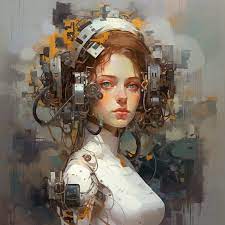The Dawn of AI in Art
In recent years, artificial intelligence (AI) has made significant strides in the realm of creative expression, giving rise to a burgeoning field known as AI art. This innovative fusion of technology and artistry has sparked widespread fascination and debate, as AI algorithms demonstrate remarkable capabilities in generating and manipulating visual and auditory content. In this article, we delve into the world of AI art and explore how creativity flourishes in the digital age.
The Evolution of AI Art
1. Generative Adversarial Networks (GANs)
- GANs have emerged as a powerful tool for generating realistic images and videos by pitting two neural networks against each other – a generator and a discriminator. This adversarial process results in the creation of increasingly convincing and diverse visual content, blurring the lines between human and machine creativity.
2. Style Transfer Algorithms
- Style transfer algorithms leverage deep learning techniques to apply the visual style of one image to another, producing stunning and often surreal artistic transformations. By extracting and combining stylistic features from reference images, these algorithms enable artists and designers to explore new aesthetic possibilities and push the boundaries of traditional art forms.
3. Neural Audio Synthesis
- AI-powered tools for audio synthesis are revolutionizing the music industry by enabling the creation of original compositions and soundscapes. These neural networks can analyze existing music samples and generate new melodies, harmonies, and rhythms, opening up endless possibilities for musical experimentation and innovation.
The Impact of AI on Artistic Creativity
1. Democratization of Creativity
- AI art tools democratize the creative process by making artistic tools and techniques more accessible to a broader audience. With user-friendly interfaces and intuitive controls, individuals with varying levels of artistic experience can explore their creativity and express themselves through digital art forms.
2. Exploration of New Aesthetic Frontiers
- AI algorithms push the boundaries of traditional artistic expression, allowing creators to explore new aesthetic frontiers and challenge conventional notions of beauty and meaning. By leveraging computational techniques and machine learning, artists can create artworks that defy categorization and provoke thought-provoking discussions about the nature of art and technology.
3. Collaboration between Humans and Machines
- AI art blurs the distinction between human and machine creativity, fostering new modes of collaboration between artists and intelligent algorithms. As artists embrace AI tools as creative partners rather than mere tools, they discover new ways to augment their own artistic vision and unlock previously unattainable levels of creativity and expression.
Challenges and Considerations
1. Ethical Implications
- The rise of AI art raises ethical questions regarding authorship, ownership, and authenticity. As AI algorithms autonomously generate artworks, issues of attribution and intellectual property rights become increasingly complex, challenging traditional notions of artistic ownership and creativity.
2. Bias and Fairness
- AI algorithms are susceptible to bias and prejudice inherent in the data they are trained on, raising concerns about the perpetuation of stereotypes and inequalities in AI-generated art. It is essential for developers and artists to address these issues proactively and strive for fairness and inclusivity in AI art.
Embracing the Creative Potential of AI
As AI continues to evolve and permeate every aspect of human society, its impact on the world of art and creativity is undeniable. While AI art presents new challenges and considerations, it also offers unprecedented opportunities for innovation, collaboration, and self-expression. By embracing the creative potential of AI, we can usher in a new era of artistic exploration and discovery that transcends the boundaries of human imagination.




